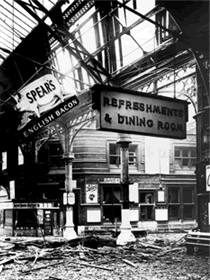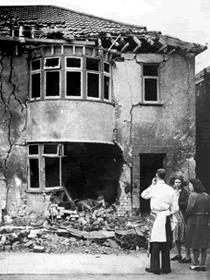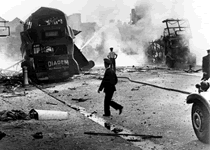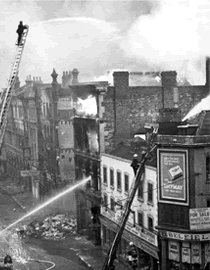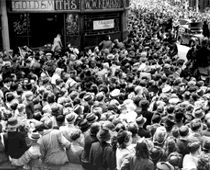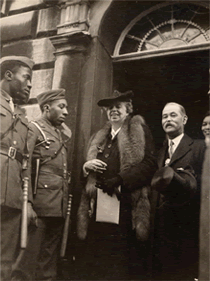


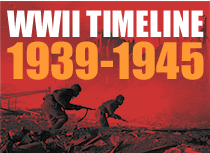
January 29 1941
Out to see rooms at Redhill [for rent as a night refuge in a farmer’s cottage] But we have come across a snag – we cannot leave our Bristol home without a firewatcher on the premises. Also, there is a general feeling of animosity towards those who leave their homes as soon as the sirens go, thus leaving it to the residents who remain, to attend them.
8 April 1941
I have brought three identification bracelets, each engraved with one of our names and our address. These will serve to identify us should we be buried under debris, or receive a direct hit.
12 April 1941
Bedminster is said to be a shambles and the Centre is badly damaged. Cheltenham Road Library was burnt out, and while ablaze made us a good target for the enemy. Daddy was busy all night putting out incendiary bombs dropped in our garden and in our neighbours’... Mr Churchill was said to be in Bristol, viewing the damage.
The Prime Minster, Churchill did indeed come to the city on a morale boosting visit the day after the Good Friday raid of 11 April 1941 in which 180 were killed. Newsreels showed cheerful, flag-waving crowds but his presence caused some resentment.
They came to where I lived and they gathered up the school kids from the local schools like St Gabriel’s and gave them flags and wavers to wave. There was such hostility from some of the women who lived in John Street where they’d lost friends and relatives that one of the women went and snatched things away... She was snatching flags and when Churchill actually turned up the women turned on him, became very hostile and started booing and shouting abuse at him.
Not only were they very tired, not only were they fed up with the bombing but they were also very, very hungry... People couldn’t bottle it up any more and Churchill was the focal point. There were also a great deal of bad feeling against some of the officials. There were suggestions that there was a lot of black marketing going on. They were the epitome – they looked content. But look at us! We’re down on our uppers! That’s what came out at that
demonstration’.
US troops arrived in the city in August 1942. Although there was some resentment about the visitors – ‘over-paid, over-sexed, over-fed and over here’ – relations were generally good and Bristolians enjoyed the luxuries, dance music and fresh outlook the GIs brought with them. However, West at War includes accounts of the violence that occasionally broke out as a result of the US military’s segregation of black and white troops:
There were many incidents of white GI’s going down to the ‘black’ pubs like the Spread Eagle in Old Market Street, and starting a fight if they found white girls there. Once there was a group of white paratroopers who literally hunted in packs, looking for black men to beat up and it turned into a riot. I was with two friends and we stood in the cinema doorway in Old Market and watched it happen, as they fought along Old Market and into West Street. Everyone says it didn’t happen and no records exist, but it did, it was hushed up.
On 15 July 1944 a brawl involving over 400 GIs and 120 military police led to several serious injuries and at least one death. It broke out when a group of white Americans, many of whom came from the South, objected to black men gathering socially in Park Street and Great George Street, a ‘white’ area. Locals were largely sympathetic to the black troops and one Bristol woman was fined for assaulting a military policeman who she saw hitting a black GI during the fight. The city remained under military curfew for some days afterwards.
During the raids on Bristol a total of 1,299 people died, 3,305 were injured, 3,000 homes were destroyed and 90,000 homes were damaged. With the end of the war and the VE and VJ celebrations people began to look to the future. There was a feeling of hope in the air and a determination to change, not going back to the bleak pre-war existence when so many people’s lives had been blighted by the Depression. It was this yearning for change that contributed to the Labour victory in the 1945 General Election. A local Labour Councillor recalled:
We dreamed of a better tomorrow, a socialist Britain, it was our Utopia. It would give the working class a bigger slice of the cake and there would be equal opportunities for all.
Some felt they had derived some personal benefit from the hardship they had endured. One woman recorded in West at War said:
I always feel very fortunate. We were in the thick of it and we came through and it made me learn the value of everything. I feel I am a better person for going through it.
Others were less positive about the experience. Looking back on the jubilation in the streets at the end of the war, one war widow said:
I felt a bit bitter. Everyone was celebrating but I felt I couldn’t, I thought what have I got to celebrate, I’ve lost my husband, we were very much in love. I’ve still got John’s photo on the sideboard, and sometimes I re-read my diaries and go through it all again, which is silly because it starts me off feeling sad. But I can’t help doing it, I just want to re-live it and not forget.
A survivor of the raid on Filton said:
I always think about [those who died], even now. I have a photograph of the bronze memorial plaque that’s in the Filton canteen, and I get it out every now and then and go through all the names, and think about them... It was all a long time ago, but yes, you feel sad.
For further information, download the Britain at War section from the readers’ guide as a PDF or Word document at the bottom of the page.
See the Timeline of World War Two for key dates.
To share memories of the Bristol front line experience go to the Reader Contributions page.
Details of West at War and other books and resources can be found in the Bibliography and Resources section.
